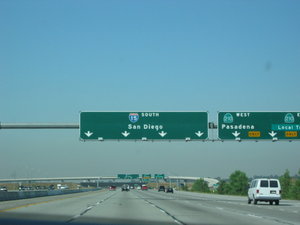Advertisement
Published: September 30th 2008

 Welcome to San Diego!
Welcome to San Diego!
Finally. We are here!After waking up in Barstow, we made a beeline for San Diego. We checked in to the BOQ at 32nd Street Naval Station and took off so that Axel could show Laurie all of the San Diego sights.
Firs stop - Point Loma. It was on Point Loma that we learned a very valuable lesson: water and cell phones don’t mix. We decided to take pictures from the cliffs despite the fact that high tide was quickly coming in. Just as a nice couple was warning us of the rogue waves that have been crashing high onto the cliffs every few minutes, one came up and nailed Axel from the waist down. Unfortunately, it killed his cell phone which was in is pocket. Laurie thought this was hilarious!
Point Loma is a wonderful San Diego landmark and has some of the best city views and sunsets.
Though archeology shows signs of Native American and prehistoric inhabitants, they were long gone when, on September 28, 1542, Juan Rodríguez Cabrillo and his crew landed on Point Loma raising the Spanish flag. After six days of exploration, Rodríguez Cabrillo named the Port "San Miguel Bay" and set sail.
Around 1796

 Axel and the Ocean
Axel and the Ocean
Just after the rogue wave...the Spanish built a small adobe fort on "Punta de los Guijarros" ("Point of the cobblestones"), modern Ballast Point, Point Loma. It served in two battles against American smugglers in 1803 and 1828. Later, ironically, abandoned guns from the fort came to be used by American forces in 1848 during the Mexican American war.
By the 1800's Point Loma began to take some of the shape we might recognize today. In 1852 President Fillmore set aside a large portion of Point Loma for military use. In 1855 a Lighthouse on Point Loma was established to serve the entrance to San Diego Bay. Then, in 1858 a whaling station was built on Ballast Point next to a Chinese fishing camp. It's this whaling station that brought the men of Portugal as well as New Zealand, Australia, Africa, England, South Pacific, and all over the world to Point Loma. But it would be the Portuguese whose imagination would most be captured by Point Loma.
The Portuguese settlement of Point Loma began in the 1880's in the "La Playa" area. By the 1920's there was a robust settlement of Portugese fishermen and families. By the 1930's San Diego was fondly known
as the "Tuna Capital of the World". By the 1940's the tuna clippers in San Diego where mostly controlled by the Portuguese of Point Loma and brought the San Diego economy an estimated 30 million dollars per year.
By the 1980's the fishing industry, mostly tuna, began a fast decline. Though international completion is sometimes cited, "environmental awareness" caused the passing of laws making it nearly impossible for the industry to continue.
Advertisement
Tot: 0.088s; Tpl: 0.012s; cc: 6; qc: 45; dbt: 0.0354s; 1; m:domysql w:travelblog (10.17.0.13); sld: 1;
; mem: 1.1mb

 Welcome to San Diego!
Welcome to San Diego!
 Axel and the Ocean
Axel and the Ocean